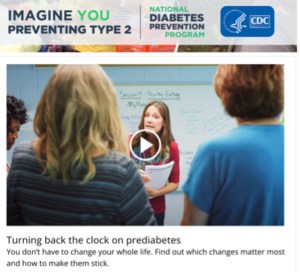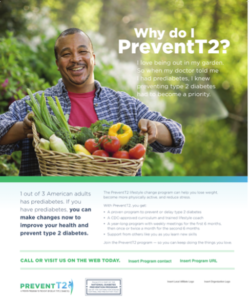Build Awareness
Back to: 5. Plan for Recruitment and Enrollment

As we explore the options for recruitment and enrollment strategies in this step, it’s important to consider that whatever path you decide to take, building organization-wide awareness of the lifestyle change program is important. Knowing that this new benefit exists to support those at risk, your employees can feel good about the ways you are prioritizing company wellness.
You can build awareness about both prediabetes and the National DPP lifestyle change program in many ways. And your role may change depending on how your benefit is structured and who you’re partnering with. Planning ahead is useful, as a comprehensive awareness strategy can begin months in advance of your program start date. Here are a few quick ways to start building awareness of prediabetes and the National DPP lifestyle change program in your organization:- Determine which existing resources you will use to raise awareness—or whether you will create your own.
- Host informational sessions to raise awareness of the National DPP lifestyle change program in your organization.
- Identify the communication methods you will use to reach your intended audience and think about your overall engagement strategy.
Determine existing resources
You don’t have to start from scratch. Many tools and resources exist to help you build awareness of the National DPP lifestyle change program. Take time to review these resources and consider which, if any, you want to use. Many of these resources include materials that can be customized by adding the name of your organization or program. If you’re working with a vendor or CDC-recognized organization, you can ask them if they have promotional materials that you can use.Host Informational Sessions
You can provide an informational session, called a Discovery Session or “Session Zero,” to build awareness of the National DPP lifestyle change program among your employees. This session covers the program’s goals, structure, and expected commitments. Potential participants may be able to meet a Lifestyle Coach and explore their readiness for lifestyle change. Employees can also enroll in the program during informational sessions if they’re interested. Consider offering a few sessions at different times and locations and in different formats (virtual and in-person) to make them accessible to anyone interested. Promote the sessions early and often to help build excitement and interest.Identify Communication Methods
There are many ways to let employees know about your National DPP lifestyle change program benefit. As noted in earlier steps, a variety of materials are available, including videos, posters, flyers, and language for newsletter articles. Think about what typically works with your employees. The best methods are often those you’ve used before for other health promotion campaigns. Where possible, use your existing channels and processes to keep things easy for yourself and familiar for your employees. Here are a few things to consider:- Beyond materials, what other assets can you use? Do you have wellness champions who can help spread the word? What about a champion who has already participated in the program? Do you have upcoming health fairs or screening events where you can promote the program?
- Clearly define your audience before you begin your promotional efforts. If the program is not available to all employees or is only available at certain locations, make sure this information is clear.
- How broad will your efforts be? A large, population-wide awareness campaign will require different communication methods than a campaign intended only for employees identified as eligible.
- Take advantage of partner distribution channels and communication methods where possible. Consistent and repetitive messages can help “cut through the clutter.” Having multiple people talk about the importance of diabetes prevention and the opportunity to participate in the National DPP lifestyle change program can amplify your efforts.
You may want to use a tailored approach designed to reach only eligible employees, rather than all employees. If you choose this method, remember to consult with your human resources team or legal counsel about issues related to confidentiality. You want to understand and prevent protected health information or HIPAA violations.



